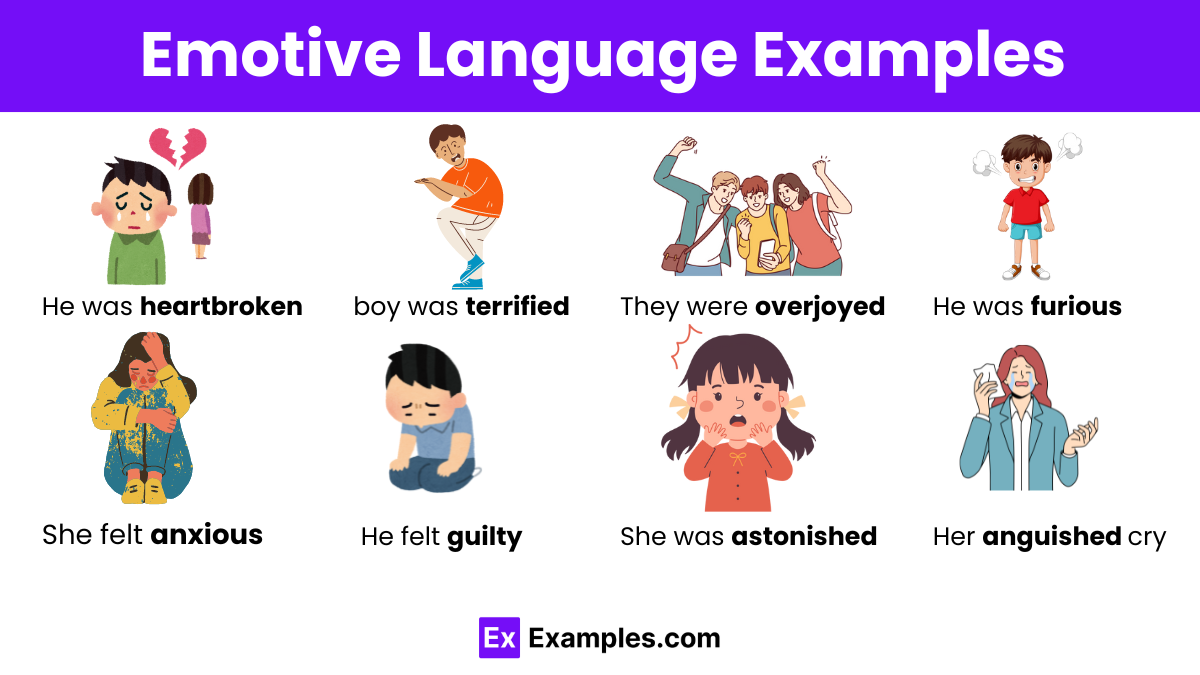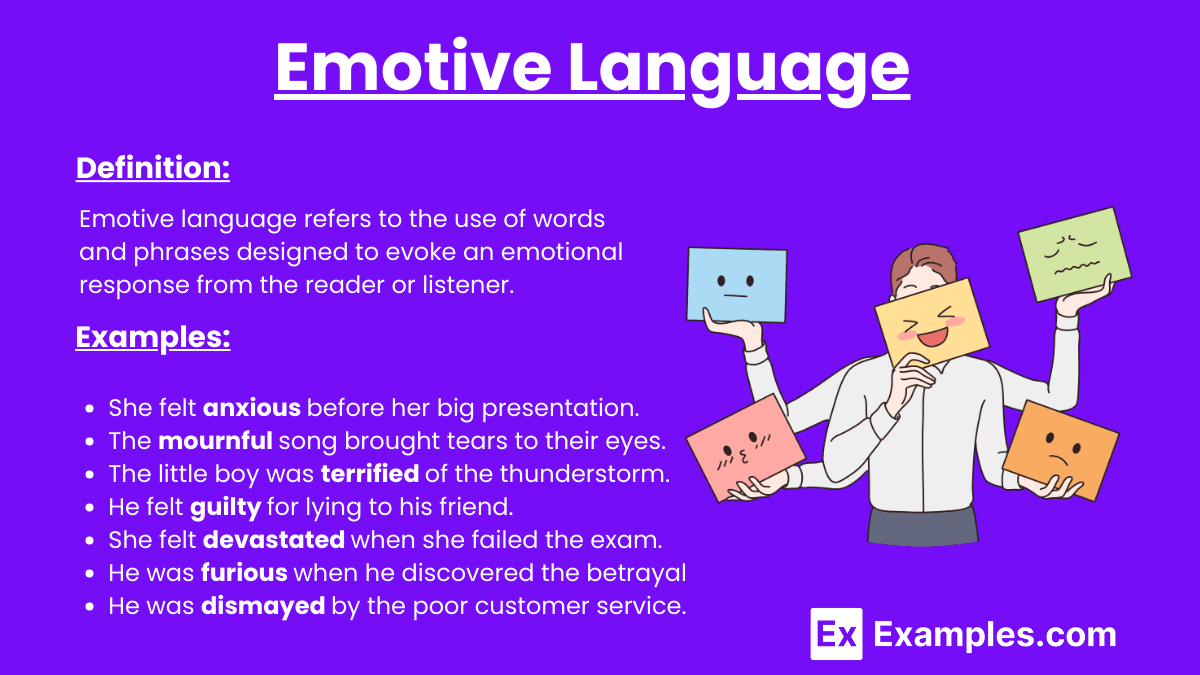50+ Emotive Language Examples
Emotive language refers to the use of words and phrases designed to evoke an emotional response from the reader or listener. This type of language aims to influence feelings rather than convey factual information. By carefully choosing words with strong connotations, a speaker or writer can make their audience feel happy, sad, angry, excited, or any other emotion. Emotive language is often used in persuasive writing, speeches, advertisements, and political rhetoric to create a connection with the audience and to reinforce the message being delivered.
What is Emotive Language?
Emotive language uses words and phrases to evoke emotional responses from the audience. It aims to persuade by appealing to feelings, using strong adjectives, powerful verbs, and expressive nouns. This language style influences the reader’s perception and engagement by triggering emotions like happiness, sadness, anger, or empathy.
Emotive Language Examples

Emotive language can evoke strong emotional responses from readers or listeners. Here are 20 examples:
- She was elated when she received the news of her promotion.
- He was heartbroken after his beloved pet passed away.
- The little boy was terrified of the thunderstorm.
- The audience was exhilarated by the breathtaking performance.
- She felt devastated when she failed the exam.
- He was furious when he discovered the betrayal.
- They were overjoyed at the birth of their first child.
- She felt anxious before her big presentation.
- The speech left everyone feeling inspired and hopeful.
- Looking at old photographs made her feel nostalgic.
- He felt guilty for lying to his friend.
- Despite the challenges, she remained hopeful for the future.
- The mournful song brought tears to their eyes.
- She was astonished by the unexpected turn of events.
- He was dismayed by the poor customer service.
- The children were thrilled to go to the amusement park.
- he melancholic atmosphere of the rainy day made him reflective.
- Her anguished cry echoed through the empty house.
- They were ecstatic about their team’s victory.
- She was disheartened by the negative feedback.
Examples of Emotive Language in Famous Speeches
Emotive language plays a crucial role in delivering powerful and memorable speeches. It appeals to the audience’s emotions, creating a lasting impact. Here are some notable examples from famous speeches that effectively use emotive language:
Martin Luther King Jr. – “I Have a Dream”
Quote: “I have a dream that my four little children will one day live in a nation where they will not be judged by the color of their skin but by the content of their character.”
Emotive Words: Dream, children, judged, content of their character
Winston Churchill – “We Shall Fight on the Beaches”
Quote: “We shall fight on the beaches, we shall fight on the landing grounds, we shall fight in the fields and in the streets, we shall fight in the hills; we shall never surrender.”
Emotive Words: Fight, beaches, never surrender
Franklin D. Roosevelt – “Pearl Harbor Address to the Nation”
Quote: “Yesterday, December 7, 1941—a date which will live in infamy—the United States of America was suddenly and deliberately attacked by naval and air forces of the Empire of Japan.”
Emotive Words: Infamy, suddenly, deliberately, attacked
John F. Kennedy – Inaugural Address
Quote: “Ask not what your country can do for you—ask what you can do for your country.”
Emotive Words: Country, ask, do, you
Nelson Mandela – “Release from Prison” Speech
Quote: “I have walked that long road to freedom. I have tried not to falter; I have made missteps along the way.”
Emotive Words: Long road, freedom, falter, missteps
Examples of Emotive Language in Persuasive Writing
- Freedom: “Every human being deserves the freedom to live without fear.”
- Injustice: “It is an injustice that so many people suffer in silence.”
- Hope: “We must hold onto hope, even in the darkest times.”
- Courage: “It takes immense courage to stand up for what is right.”
- Desperation: “The desperation in their eyes was a call for immediate action.”
- Compassion: “Our society needs more compassion and understanding.”
- Anger: “The community’s anger is a direct response to systemic failure.”
- Joy: “Imagine the joy of a child who finally has access to education.”
- Sacrifice: “Their sacrifice should never be forgotten or taken for granted.”
- Empathy: “We must approach this issue with empathy and care.”
- Pride: “We take great pride in our accomplishments, but we must do more.”
- Grief: “The grief of losing a loved one to preventable causes is unbearable.”
- Frustration: “The widespread frustration is a clear sign that change is needed.”
- Love: “Love for our planet should drive us to protect the environment.”
- Shock: “The shocking reality of poverty in our nation is unacceptable.”
- Determination: “With determination, we can overcome any obstacle.”
- Shame: “It is a shame that so many still go hungry in a land of plenty.”
- Inspiration: “Her story is an inspiration to all who face similar struggles.”
- Urgency: “There is an urgent need to address climate change.”
- Outrage: “The public outrage over the injustice cannot be ignored.”
Examples of Emotive Language in Literature
- Pride and Prejudice by Jane Austen
- Sentence: “It is a truth universally acknowledged, that a single man in possession of a good fortune, must be in want of a wife.”
- Emotive Language: The phrase “universally acknowledged” evokes a sense of shared societal expectation and urgency.
- To Kill a Mockingbird by Harper Lee
- Sentence: “People generally see what they look for, and hear what they listen for.”
- Emotive Language: This sentence uses a reflective tone that evokes a sense of introspection and judgment.
- 1984 by George Orwell
- Sentence: “War is peace. Freedom is slavery. Ignorance is strength.”
- Emotive Language: The use of paradoxical statements creates a sense of confusion and manipulation, evoking feelings of fear and oppression.
- The Great Gatsby by F. Scott Fitzgerald
- Sentence: “So we beat on, boats against the current, borne back ceaselessly into the past.”
- Emotive Language: The imagery of struggling against an inevitable force evokes feelings of futility and nostalgia.
- Wuthering Heights by Emily Brontë
- Sentence: “Whatever our souls are made of, his and mine are the same.”
- Emotive Language: The intense connection described here evokes deep emotions of love and unity.
Emotive Language Words
Positive Emotive Words
- Joyful
- Ecstatic
- Elated
- Content
- Grateful
- Hopeful
- Inspired
- Loving
- Proud
- Thrilled
Negative Emotive Words
- Angry
- Devastated
- Heartbroken
- Terrified
- Anxious
- Guilty
- Hopeless
- Mournful
- Furious
- Disheartened
Neutral Emotive Words (Context-Dependent)
- Surprised
- Amazed
- Curious
- Reflective
- Intrigued
Emotive language Phrases
- Over the moon: “I was over the moon when I heard the news!”
- Crushed: “He felt crushed by the sudden loss of his job.”
- On cloud nine: “She was on cloud nine after winning the award.”
- Heart-wrenching: “The movie’s ending was absolutely heart-wrenching.”
- In tears: “The audience was in tears by the end of the performance.”
- Beside myself with joy: “I was beside myself with joy when my sister announced her engagement.”
- Devastated: “She was devastated when she learned about the accident.”
- Thrilled to bits: “He was thrilled to bits when his team won the championship.”
- Broken-hearted: “The breakup left her broken-hearted.”
- On top of the world: “I felt on top of the world after completing the marathon.”
Uses of Emotive Language
Emotive language plays a crucial role in communication, helping to convey feelings and evoke emotional responses from the audience. Here are several key uses of emotive language:
1. Persuasion
Emotive language is often used to persuade an audience by appealing to their emotions rather than their logic. Advertisements, political speeches, and persuasive essays frequently use emotive language to influence opinions and encourage specific actions.
Example: “Join us in the fight against injustice and stand up for what is right!”
2. Creating a Strong Connection
Using emotive language can help build a strong emotional connection between the speaker and the audience. This connection can make the message more memorable and impactful.
Example: “We share your dreams and understand your struggles.”
3. Enhancing Storytelling
Emotive language enriches storytelling by making characters and situations more vivid and relatable. It helps readers or listeners to empathize with characters and become more immersed in the narrative.
Example: “Her heart pounded as she faced the daunting challenge ahead.”
4. Highlighting Importance
Emotive language can emphasize the significance of an event, idea, or action. It draws attention to key points and ensures that the audience understands their importance.
Example: “This is a momentous occasion that will shape our future.”
5. Evoking Sympathy or Empathy
Emotive language can be used to evoke sympathy or empathy from the audience, helping them to understand and feel the emotions of others. This is particularly effective in personal stories and testimonials.
Example: “Imagine the pain of losing a loved one so suddenly.”
Techniques of Emotive language
- Loaded Words: Using words with strong connotations to elicit emotions (e.g., “freedom,” “betrayal”).
- Imagery: Creating vivid pictures in the reader’s mind to evoke emotions.
- Metaphors and Similes: Comparing one thing to another to create emotional connections.
- Hyperbole: Exaggerating for emphasis to evoke strong feelings.
- Repetition: Repeating words or phrases to reinforce an emotional message.
- Personal Anecdotes: Sharing personal stories to create a connection and elicit empathy.
- Direct Address: Speaking directly to the audience to engage them emotionally.
- Appeals to Values: Referencing shared beliefs or morals to connect emotionally.
- Contrast: Highlighting differences to emphasize emotional points.
- Rhetorical Questions: Asking questions that do not require answers to provoke thought and emotion.
FAQ’s
Why is emotive language important?
Emotive language is important because it can persuade, engage, and influence the audience, making messages more impactful and memorable.
How does emotive language affect the reader?
Emotive language affects the reader by evoking strong emotions, which can lead to a deeper connection with the content and a stronger reaction.
Can you give an example of emotive language?
An example of emotive language is: “The innocent child suffered a cruel fate,” where “innocent” and “cruel” evoke empathy and anger.
How is emotive language used in advertising?
In advertising, emotive language is used to create desire, urgency, or sympathy, making products more appealing and memorable to consumers.
Is emotive language always effective?
Emotive language is not always effective. If overused or insincere, it can seem manipulative and may alienate the audience.
How can writers use emotive language ethically?
Writers can use emotive language ethically by being truthful, avoiding manipulation, and respecting the audience’s emotions and intelligence.
What is the difference between emotive language and persuasive language?
Emotive language focuses on eliciting emotions, while persuasive language aims to convince or persuade the audience using logical arguments and emotional appeals.
How does emotive language enhance storytelling?
Emotive language enhances storytelling by creating vivid, emotionally charged scenes that engage readers and make the narrative more compelling.
Can emotive language be negative?
Yes, emotive language can be negative. Words like “horrific,” “disastrous,” or “heartbreaking” evoke negative emotions such as fear, sadness, or anger.
Can you use emotive language in academic writing?
Emotive language is generally avoided in academic writing as it aims to present objective, evidence-based arguments without emotional bias.



